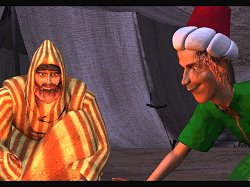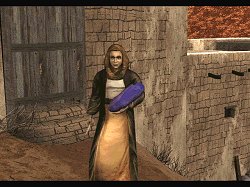|
The Secrets of Alamut
 The Secrets of Alamût is the second part of the story that began in The Legend of the Prophet and the Assassin and takes up immediately from where that game left off. Tancrède de Nerac, known as As-Sayf (the Scimitar) must continue his search for Simon the prophet ... his need for vengeance is undiminished. The Secrets of Alamût is the second part of the story that began in The Legend of the Prophet and the Assassin and takes up immediately from where that game left off. Tancrède de Nerac, known as As-Sayf (the Scimitar) must continue his search for Simon the prophet ... his need for vengeance is undiminished.
If you haven't played the first part then a brief overview is provided which you can view by selecting it from the main menu. Strangely, this option is not mentioned in the manual. However, to get a real feel for the whole story I strongly recommend that you play both games in order as The Secrets of Alamût more or less drops you in at the deep end so it doesn't totally stand alone as a distinct game. This is not to say that it isn't enjoyable, indeed I enjoyed this part more than the first, and if the two parts had been available as one complete game I would have no hesitation in recommending it as excellent value.
Unfortunately, this second instalment, whilst a fitting finale to the story, is just too short to be truly satisfying as a stand-alone game. Clearly, what we have here is one good solid adventure game that has been split into two parts for commercial reasons which I think does not reflect well on Arxel tribe and can be seen as a disservice to adventure game players who will have to pay twice to get the full experience unless it subsequently ships as one product. (*See note below)
 Having said that, The Secrets of Alamût does provide some fascinating locations to explore and an interesting variety of obstacles to overcome. After recently playing Arthur's Knights: Tales of Chivalry it was great to return to a game where I felt I could interact meaningfully with items in the gameworld and experiment with the puzzles.
There are a couple of timed sequences, but these are easily negotiated and one or two puzzles that have a mild arcade-type feel though they are not onerous and some judicious saving should see you safely through them. For the most part the puzzles are logical and in context in that you learn what you need to do by exploring your surroundings, finding and using items (don't forget to try to combine things in your inventory) and thinking about what you are trying to achieve. The first few puzzles have an Indiana Jones feel to them as you move through a sequence of cunning traps never quite sure if your next step will be your last.
There is much less character interaction here than in the first part and consequently less of the feel of being pulled along by the dictates of the story. Perhaps that is the reason it appealed to me more. In this game I felt more involved and that I was more in control. By solving the puzzles I was moving the story forward. To that extent the theme of the story, which on one level was a journey of self discovery by confronting and overcoming a series of challenges, had a resonance in the actual gameplay. The simple symbolism illustrated by As-Sayf's descent into the mine (underworld) and subsequent return is nevertheless quite powerful. Having said that, The Secrets of Alamût does provide some fascinating locations to explore and an interesting variety of obstacles to overcome. After recently playing Arthur's Knights: Tales of Chivalry it was great to return to a game where I felt I could interact meaningfully with items in the gameworld and experiment with the puzzles.
There are a couple of timed sequences, but these are easily negotiated and one or two puzzles that have a mild arcade-type feel though they are not onerous and some judicious saving should see you safely through them. For the most part the puzzles are logical and in context in that you learn what you need to do by exploring your surroundings, finding and using items (don't forget to try to combine things in your inventory) and thinking about what you are trying to achieve. The first few puzzles have an Indiana Jones feel to them as you move through a sequence of cunning traps never quite sure if your next step will be your last.
There is much less character interaction here than in the first part and consequently less of the feel of being pulled along by the dictates of the story. Perhaps that is the reason it appealed to me more. In this game I felt more involved and that I was more in control. By solving the puzzles I was moving the story forward. To that extent the theme of the story, which on one level was a journey of self discovery by confronting and overcoming a series of challenges, had a resonance in the actual gameplay. The simple symbolism illustrated by As-Sayf's descent into the mine (underworld) and subsequent return is nevertheless quite powerful.
 The interface and controls are point and click and unchanged from the first game so I won't dwell on them here except to repeat that I still prefer to be able to identify items in the gameworld before picking them up. Similarly, as a continuation rather than a sequel, the voice acting, music and graphics are all uniformly well done as in part one and there are subtitles throughout. The game ships on two CDs and doesn't require you to insert the first disk to start when you have moved on to the second disk.
In my review of The Legend of the Prophet and the Assassin I said that Simon fails to make an appearance by the end of the game. I know now that I was wrong, but you will just have to play The Secrets of Alamût to see why. The end sequence carries a simple statement from Simon that is truly thought provoking. This one short sentence reveals much about the way we think of leaders and followers, the paths to redemption, even institutionalised 'spirituality'. In the game context it also reveals why Simon never made it to Jebus. All things considered the understated denouement provides a satisfying conclusion to this tale.
*(Note: DreamCatcher in North America is releasing The Legend of the Prophet and the Assassin and The Secrets of Alamût as one game). The interface and controls are point and click and unchanged from the first game so I won't dwell on them here except to repeat that I still prefer to be able to identify items in the gameworld before picking them up. Similarly, as a continuation rather than a sequel, the voice acting, music and graphics are all uniformly well done as in part one and there are subtitles throughout. The game ships on two CDs and doesn't require you to insert the first disk to start when you have moved on to the second disk.
In my review of The Legend of the Prophet and the Assassin I said that Simon fails to make an appearance by the end of the game. I know now that I was wrong, but you will just have to play The Secrets of Alamût to see why. The end sequence carries a simple statement from Simon that is truly thought provoking. This one short sentence reveals much about the way we think of leaders and followers, the paths to redemption, even institutionalised 'spirituality'. In the game context it also reveals why Simon never made it to Jebus. All things considered the understated denouement provides a satisfying conclusion to this tale.
*(Note: DreamCatcher in North America is releasing The Legend of the Prophet and the Assassin and The Secrets of Alamût as one game).
Copyright © Gordon Aplin 2001.
All rights reserved.
System Requirements:
Win 95/98/2000, P200 MMX, 32MB RAM, 290 MB free hard disk space, mouse, SoundBlaster compatible soundcard, 16-bit color graphics (24-bit recommended), 2MB video memory.
|

